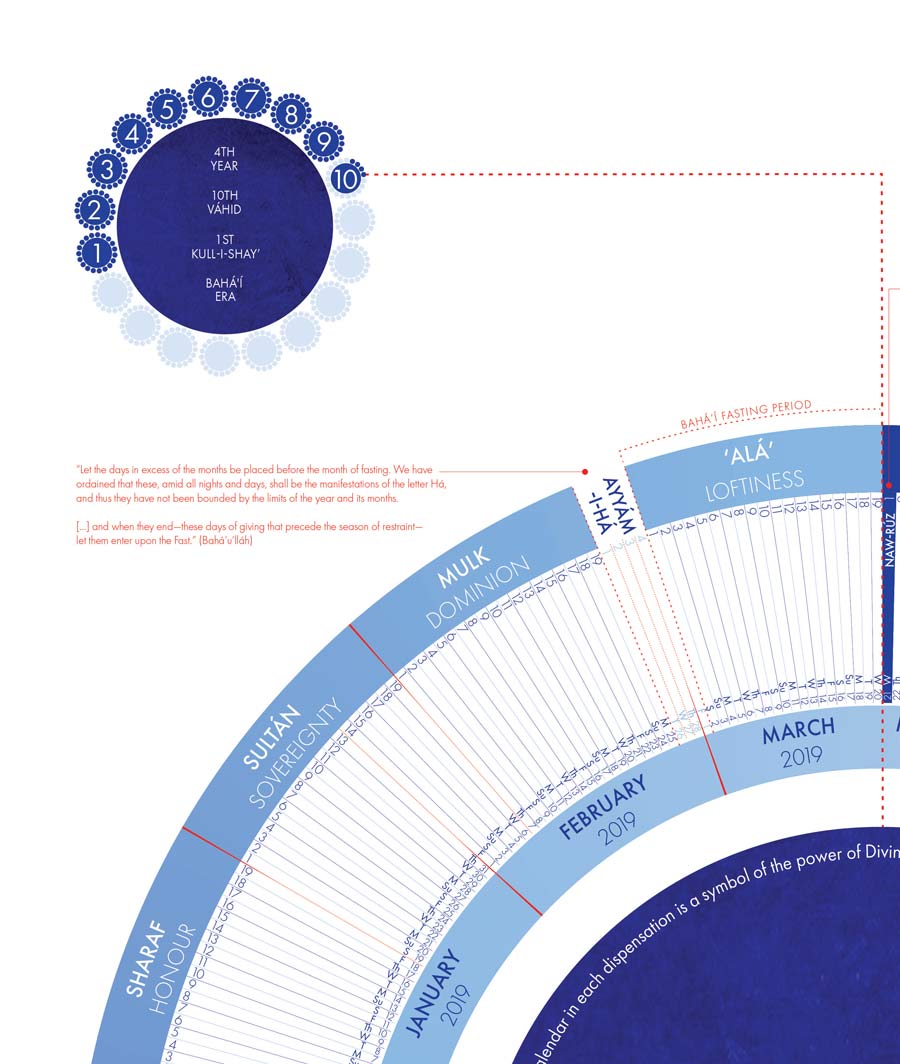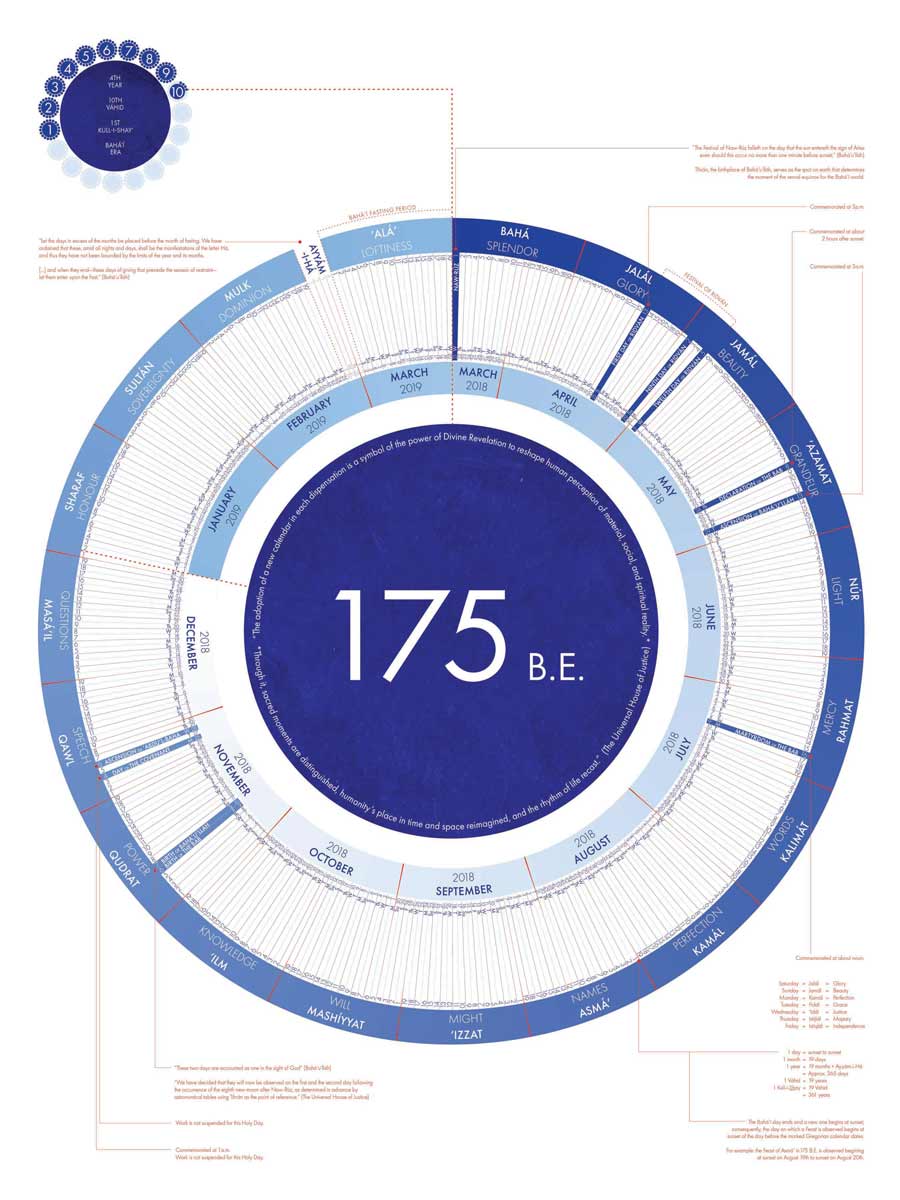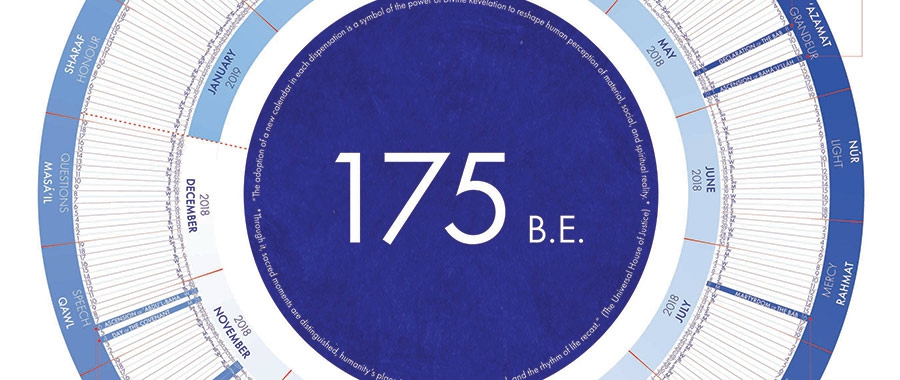The views expressed in our content reflect individual perspectives and do not represent the authoritative views of the Baha'i Faith.
Have you noticed the Baha’is have an entirely new and different calendar?
In this article, Shadi Toloui-Wallace interviews Roya Mottahedeh about her original artwork, which helps explain this new Baha’i calendar using a beautiful graphic that also incorporates the Gregorian calendar.
March 20, 2018 completes the third year of a new period in Baha’i history, in which the Baha’is of every country utilize the same calendar—known as the Baha’i or Badi calendar—in a unique way that integrates solar and lunar systems for measuring time.
This calendar, and its relation to the Gregorian and Islamic calendars, has long fascinated me. I have always loved artistic designs, so you can imagine my delight when I saw the beautiful graphic that architect and designer Roya Mottahedeh fashioned combining the Baha’i and Gregorian calendars. While delighting the eye, Mottahedeh’s work can also help us visualize how the events and cycles of this unique calendar can fit into our busy Gregorian-based schedules.
I had the opportunity to interview Roya, from her new home in Haifa, Israel to learn about the inspiration behind her design, its process and development, the creativity involved and her plans for the future.
[Shadi] Roya, I’d love to learn how this all began. How did your idea for this calendar ignite? What inspired you to design it, and why the Badi calendar specifically?
 [Roya] The idea originated mostly from my curiosity about how the Badi calendar works and how it relates to the Gregorian calendar, which I, and much of the world, use on a daily basis. Both calendars correspond to one full rotation around the sun, but each has a different arrangement of months and days. Another part of my motivation is that I am quite bad at remembering important dates—such as Baha’i Holy Days. When the Universal House of Justice wrote a letter—dated July 10, 2014—announcing the universal implementation of the Badi Calendar, I was intrigued … and yet mostly confused as to what exactly this entailed. Last year, as Baha’is around the world planned celebrations marking the bicentenary of the birth of Baha’u’llah, I was inspired to explore this unique calendar in the only way I really know how—through graphics and diagrams.
[Roya] The idea originated mostly from my curiosity about how the Badi calendar works and how it relates to the Gregorian calendar, which I, and much of the world, use on a daily basis. Both calendars correspond to one full rotation around the sun, but each has a different arrangement of months and days. Another part of my motivation is that I am quite bad at remembering important dates—such as Baha’i Holy Days. When the Universal House of Justice wrote a letter—dated July 10, 2014—announcing the universal implementation of the Badi Calendar, I was intrigued … and yet mostly confused as to what exactly this entailed. Last year, as Baha’is around the world planned celebrations marking the bicentenary of the birth of Baha’u’llah, I was inspired to explore this unique calendar in the only way I really know how—through graphics and diagrams.
[Shadi] What prompted you to choose this particular style of circular design? Can you tell us about its history?
[Roya] I’ve seen Baha’i months and dates superimposed on Gregorian calendars—and vice-versa—but these tend to favor one system over the other, which is both confusing and limiting. So my design tries to address this imbalance by displaying both calendars equally and simultaneously. As I began creating it, I appreciated the snapshot it provides of all 365 days of the year at once—which, for me, emphasizes how precious each day is! There are many historical precedents for circular calendars—those of the Aztecs, the Ancient Egyptians and many other cultures—and the clock is also a circular visualization of time.
As I studied the Badi calendar, I was intrigued to learn that it contains many cycles—19 months (roughly one year), 19 years (one Vahid, meaning “unity”) and 19 Vahids (one Kull-i-Shay, meaning “all things”). These cycles date back to the beginning of the Baha’i Faith, as they were designated by the Bab, the prophet and herald of Baha’u’llah. The cycles make a beautiful fractal pattern, as shown in the image in the top left of the print.
[Shadi] What challenges did you encounter when collecting the information and designing it?

Roya Mottahedeh
[Roya] The system which the Bab created for the Badi calendar—and which Baha’u’llah clarified—is both straightforward and extremely complex. Deciding what information to include in the design—and how much of it—was definitely the most challenging part of the process.
[Shadi] What information did you end up including?
[Roya] I included the dates for the year 175 B.E., which goes from March 21, 2018 through March 20, 2019. By the way, B.E. stands for the “Baha’i Era” which began 175 years ago in 1844, when the Faith began. As you can see, I included the corresponding Gregorian dates and months for the same stretch of time. I also wove in Baha’i Holy Days and some notes on when to commemorate them, and other bits of information about the calendar. I left out sunset or sunrise times, because that varies greatly depending on one’s specific location.
[Shadi] Where did you source your information to make sure it was accurate?
[Roya] I referred to a variety of sources—documents, letters and other resources offering guidance on the topic. I also passed it by a few calendar experts to review the information. Hopefully it’s accurate!
[Shadi] How have people responded to your graphic so far?
[Roya] Surprisingly well! First, I’m lucky to have lots of helpful friends and family who encourage me in my work. It has also led to really nice conversations, with both Baha’is and friends who are not Baha’is, about the calendar—in terms of its design, but also its significance. For example, it sparked many wonderful conversations about what Baha’is call the “twin holy days”—Baha’i celebrations on two consecutive days commemorating the birthdays of the Bab and Baha’u’llah—and about the quotation I referenced on the poster, which I find very powerful:
The adoption of a new calendar in each dispensation is a symbol of the power of Divine Revelation to reshape human perception of material, social, and spiritual reality. Through it, sacred moments are distinguished, humanity’s place in time and space reimagined, and the rhythm of life recast. – The Universal House of Justice, Letter to the Baha’i World, 10 July 2014.
Pretty cool!
[Shadi] For me personally, this feels like a piece of art. I love having it displayed in a central location in my home, where visitors can easily see it. Is this what you intended?
[Roya] My intention was to create something useful and beautiful. Both of those are subjective, I guess! But I’m glad to know people are happy to have it on their walls, where they can refer to it for information, and where it might also spark conversation.
[Shadi] Will you continue making more in the future? What will keep you motivated?
 [Roya] I think I will, but I’m not sure to what extent, since these calendars take a lot of time to produce, print and distribute. However, I think this year’s graphic (175 B.E.) is even better than last year’s (174 B.E), so I hope to keep improving and refining it over time. Thankfully, I have some wonderful support, such as my sister and brother-in-law who help me with timeliness and staying on track with my deadlines. 🙂 They are also helping me print and distribute this year, so this project is a real family undertaking!
[Roya] I think I will, but I’m not sure to what extent, since these calendars take a lot of time to produce, print and distribute. However, I think this year’s graphic (175 B.E.) is even better than last year’s (174 B.E), so I hope to keep improving and refining it over time. Thankfully, I have some wonderful support, such as my sister and brother-in-law who help me with timeliness and staying on track with my deadlines. 🙂 They are also helping me print and distribute this year, so this project is a real family undertaking!
[Shadi] How can we learn more about your work, and is it available for sale?
[Roya] Yes, while supplies last! You can view and purchase it online at bahaicirclecalendar.bigcartel.com
The Baha’i calendar—also known as the Badi calendar—was first introduced in Iran in the mid-19th century by the Bab, the prophet and herald of Baha’u’llah, who founded the Baha’i Faith. The Arabic word Badi translates to “unique,” as this calendar is the first of its kind—comprised of 19 months, each made up of 19 days, for a total of 361 days. The remaining days of the year (four or five depending on the year) are intercalary days called Ayyam-i-Ha, meaning the days of Ha, which symbolize the essence of God, happiness and celebration. Every year, on March 21, Baha’is around the world celebrate the Baha’i New Year, known as Naw Ruz. Every 19 year cycle is known as a Vahid (meaning “unity”), and every cycle of 19 Vahids is known as a Kull-i-Shay (meaning “all things”). This calendar was approved by Baha’u’llah, and its universal adoption was announced in July of 2014.
Curious to learn more? Check out other BahaiTeachings.org articles regarding this unique calendar, and recent celebrations of the bicentenary of the Birth of Baha’u’llah:
















Comments
Sign in or create an account
Continue with Googleor